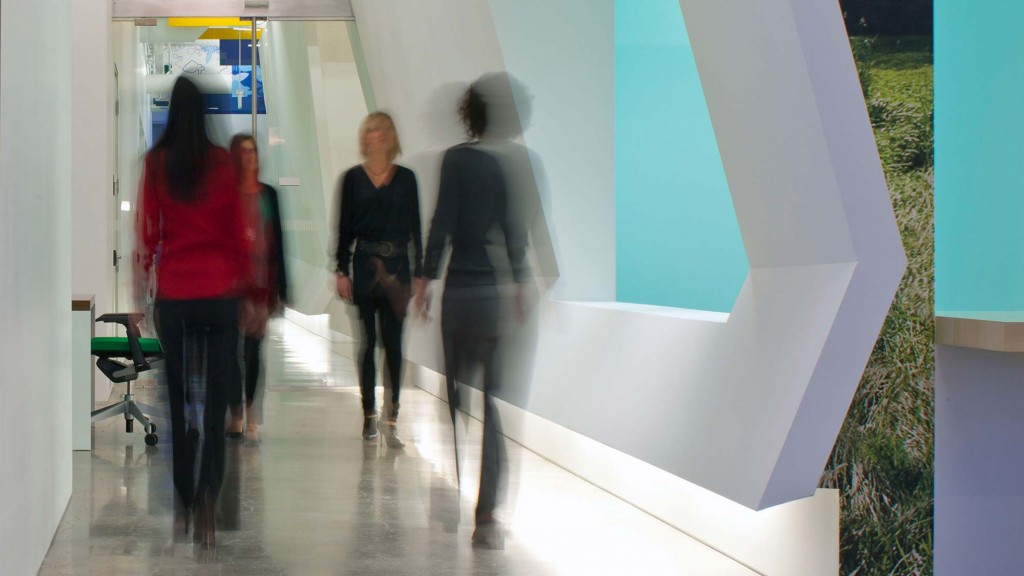How does space drive innovation?
Framework for Innovation Spaces
What We Did
Our goal was to understand what makes space more or less effective in supporting innovation as a business process and as a human activity. To accomplish this, we conducted interviews and on-site visits with managers and executives charged with innovation at top companies; compiled case studies to identify diverse tactics employed by the most innovative companies; and conducted a literature review and expert interviews to include an academic perspective on how space design can shape the transdisciplinary collaboration that characterizes innovation.
The Context
Innovation matters to our clients, now more than ever. The drive to innovate stems from the continued effects of globalization, increased competition, and the steady shift toward a knowledge economy. As companies seek to grow and maintain an edge, they are exploring numerous strategies to maximize their employees’ innovation potential. Among many factors, space is an opportunity to support these innovation agendas. Space shapes behavior, defines experiences, and (when done right) catalyzes organizational change. Companies that want to build cultures and environments to support and accelerate innovation are looking for effective space solutions that are based on empirical evidence and best-practice experiences.
The Results
Places that support innovation do so in multiple ways: (1) They interrupt siloed structures to create stronger knowledge networks; (2) they build awareness between people and departments to better support the productive flow of ideas; (3) they consider proximity between people and groups to support planned and unplanned connectivity; and (4) they create connections that increase communication and encourage the active sharing of information. Our research builds on the work of other researchers exploring the impact of space on connectivity, including the work of Thomas Allen and Gunter Henn (2007) showing how proximity and architecture can drive personal connections, and Bill Hillier’s work (1999) on the spatial logic of buildings and the ability of space to drive awareness.
Based on our case studies and interviews, it became clear to us that organizations employ myriad ways of driving innovation through the use of space, as well as management practices that leverage space to promote performance. One size doesn’t fit all for these strategies— an analysis of individual culture and goals is necessary to arrive at an application. Successful spaces are complex environments that support multiple, overlapping strategies and design tactics in support of innovation goals. In interviews with top companies, the defining characteristic of innovation space was its ability to represent multiple strategies and ideas at once. We call this kind of space “Both/And.”
What This Means
Alone & Together: Teamwork and communication are catalysts for idea generation; solitude is the environment in which people work through those ideas. Spaces that support the individual while promoting feelings of group ownership encourage a shared sense of group purpose.
Showcase & Workspace: Space holds symbolic power—more so when the goal is to foster innovation. But true innovation spaces are workspaces too, providing the tools and resources needed for work.
Designed & Undefined: The best spaces are highly designed and organized to maximize functionality, but they hide it. An undefined appearance and an ability to alter settings are key components of innovation.
Risky & Safe: Risk is an essential aspect of innovation, and the freedom to explore is essential to creativity. Creating a safe environment removes barriers to exploration and discovery by allowing employees to take risks within a safe, stable environment.
What’s Next?
We continue to explore these topics and strategies through application on specific client projects. In some cases, these take the form of enclosed or semi-enclosed workspaces or “labs” devoted specifically to the task of innovation. In others, these strategies are used more broadly to understand workspace design as a catalyst for learning and connection throughout a company.
Learn More
Team
Cindy Coleman, Mandy Graham, Tom Mulhern, Amanda Ramos
Year Completed
2012
Comments or ideas for further questions we should investigate?
